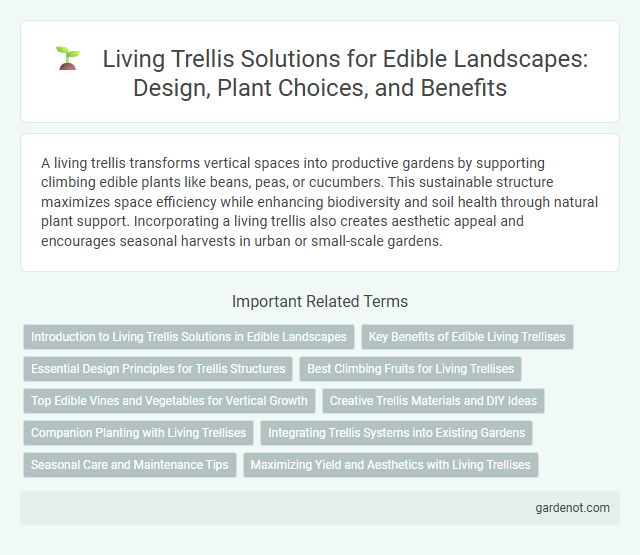A living trellis transforms vertical spaces into productive gardens by supporting climbing edible plants like beans, peas, or cucumbers. This sustainable structure maximizes space efficiency while enhancing biodiversity and soil health through natural plant support. Incorporating a living trellis also creates aesthetic appeal and encourages seasonal harvests in urban or small-scale gardens.
Introduction to Living Trellis Solutions in Edible Landscapes
Living trellis solutions in edible landscapes integrate climbing plants with structural support to maximize vertical growing space and increase food production. These systems utilize natural, sustainable materials like bamboo or recycled wood combined with fruit-bearing vines such as grapes, kiwis, or beans, enhancing both yield and aesthetic appeal. Implementing living trellises promotes biodiversity, improves air circulation, and supports healthier plant growth in urban and suburban garden designs.
Key Benefits of Edible Living Trellises
Edible living trellises maximize garden space by supporting vertical growth of fruits, vegetables, and herbs, enhancing yield per square foot. These structures improve plant health through better air circulation and sun exposure, reducing disease risk and increasing photosynthesis efficiency. Integrating edible plants into trellises also creates sustainable, low-maintenance food sources while contributing to biodiversity and aesthetic appeal.
Essential Design Principles for Trellis Structures
Living trellises integrate climbing plants into functional landscape structures, requiring essential design principles such as selecting durable, rot-resistant materials like cedar or metal to ensure longevity. Proper spacing and orientation optimize sunlight exposure for plant growth and ease of maintenance. Structural stability must accommodate the mature weight of vines, while promoting air circulation to reduce pest and disease risks.
Best Climbing Fruits for Living Trellises
Best climbing fruits for living trellises include grapes, kiwifruit, and passionfruit, renowned for their vigorous growth and high yields. These fruits thrive on vertical support, maximizing space efficiency and enhancing garden aesthetics while providing nutritious harvests. Selecting disease-resistant varieties ensures longevity and reduces maintenance for a sustainable edible landscape.
Top Edible Vines and Vegetables for Vertical Growth
Top edible vines such as passionfruit, kiwi, and hardy grape thrive on living trellises, optimizing vertical space while producing abundant, nutrient-rich fruits. Vegetables like pole beans, cucumbers, and climbing peas leverage trellis support to increase airflow and sunlight exposure, enhancing yield and disease resistance. Incorporating these edible vines and vegetables into vertical gardens maximizes production in limited spaces with minimal maintenance.
Creative Trellis Materials and DIY Ideas
Creative trellis materials for living landscapes include repurposed wood pallets, bamboo poles, and recycled metal grids, offering both functionality and aesthetic appeal. DIY ideas often incorporate upcycled garden stakes intertwined with natural twine or wire to support climbing edibles like beans and cucumbers. These innovative structures promote sustainable gardening while maximizing vertical growing space in edible landscapes.
Companion Planting with Living Trellises
Living trellises integrate companion planting by using compatible edible vines and climbing plants to maximize space and improve crop health. Species like pole beans climbing on sunflowers or cucumbers entwining around corn create mutually beneficial ecosystems that enhance nutrient uptake and pest resistance. This method optimizes vertical growing space while promoting biodiversity and sustainable garden productivity.
Integrating Trellis Systems into Existing Gardens
Integrating living trellis systems into existing gardens enhances vertical growing space while supporting fruiting vines like grapes, kiwis, and passionfruit. These structures maximize sunlight exposure and air circulation, promoting healthier plants and higher yields. Tailoring trellis designs to garden layouts preserves aesthetics and optimizes land use for sustainable edible landscapes.
Seasonal Care and Maintenance Tips
Living trellises require regular pruning to encourage healthy growth and maximize fruit production throughout the growing season. Monitor plants for pests and diseases, applying organic treatments promptly to maintain plant health and yield. Seasonal mulching and consistent watering improve soil moisture retention and support vigorous vine growth on the trellis structure.
Maximizing Yield and Aesthetics with Living Trellises
Living trellises enhance edible landscapes by combining vertical gardening with natural support structures, maximizing yield in limited spaces. These structures optimize plant health and fruit production through improved air circulation and sunlight exposure while adding sculptural beauty. Integrating climbing edibles like beans, peas, or grapes on living trellises turns garden walls into productive, visually appealing features.
Living trellis Infographic

 gardenot.com
gardenot.com